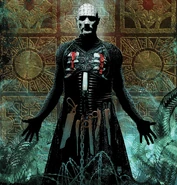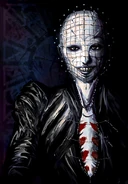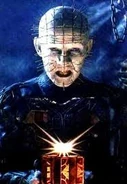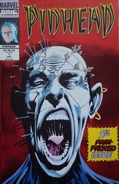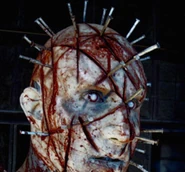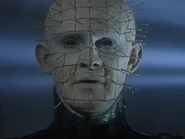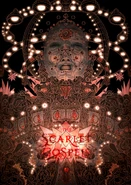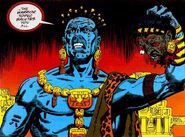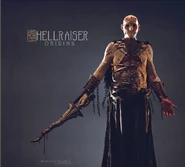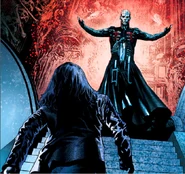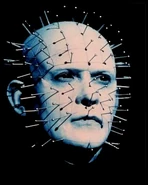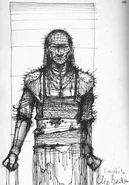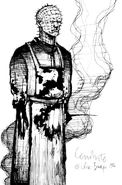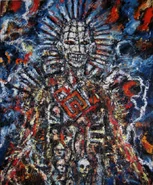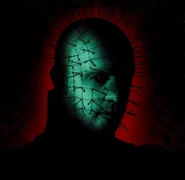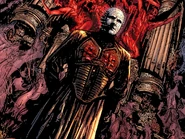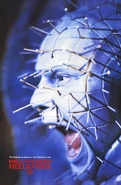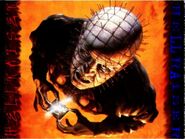| Pinhead | |
|---|---|
| File:960.jpg | |
|
Portrayed by |
Doug Bradley |
|
Status |
Deceased |
|
First Appearance |
Literature: The Hellbound Heart |
|
Latest Appearance |
Literature: The Scarlet Gospels |
|
Also Known As |
Hell Priest, Xipe Totec, Elliot Spencer, Larry |
"[Pinhead] was basically Clive's design, as seen on the Hellbound T-shirts. There was a lot of discussion with Clive, then I did a few drawings. First we just had spikes coming out of his head. I wanted it to be more geometrical. Originally he had pins all over the head, but Clive and I thought it would be nice to make it look more like a mask with pins around his chin, over his ears and at the back of his head. We modelled it about six times and did loads of drawings. If you look at the first test pictures that came out of Hellraiser there are actually pins in there rather than nails and the pins got lost - you couldn't see them. So we clipped the ends of the pins off and made our own hollow brass nails that inserted over the top and they were much more visible."
-Games Without Frontiers By Brian J. Robb, Fear, No.6, May/June 1989.
Pinhead, also known as The Hell Priest, is a Cenobite in the Order of the Gash and the main antagonist of the Hellraiser metaseries.
Character History
Pinhead's role has varied with each Hellraiser installment. In the script for the original film, Barker describes Pinhead and the other cenobites as "demons" in his notes; the character himself, however, upon capturing Kirsty Cotton, identifies himself as neither explicitly angelic or demonic, stating that he and his fellow entourage are "Explorers in the further regions of experience. Demons to some. Angels to others." The second film expounds on the idea of the Cenobites as demons by depicting them as denizens of a realm called Hell, a maze-like dimension ruled over by an entity known as Leviathan, where they subject their quarry to emotional and psychological torture.
The third film radically altered the original concept, making Pinhead into a purely evil demon of chaos, explained by Pinhead losing the human, 'orderly', part of himself during the previous film. In the fourth film he is presented as a megalomaniac bent on world domination, and by the fifth he acts as a judge, punishing those who open the box for their sins by making them face their personal demons. In this film, he goes by the title of "Engineer", a name derived from the lead cenobite in Clive Barker's original novella. The seventh film reverts closer to the original film, with the Cenobites responsible for pleasure and pain, but the characters seem more demonic as in later installments.
In The Films
In the movie series storyline, Pinhead was born Elliot Spencer and opened the Lament Configuration after becoming disenchanted with human life from his service in World War I. Like the other Cenobites, he lost all memory of his human identity following the transformation and serves the deity Leviathan by abducting others who solve the Lament Configuration and torture them in a labyrinth realm called Hell.
In Hellraiser (1987), Kirsty Cotton unintentionally summons Pinhead and the Cenobites, but is spared on condition that she lead the Cenobites to her uncle, Frank Cotton, who had escaped them. After reclaiming Frank, the Cenobites turn on Kirsty, who manages to banish them back to their realm.
In Hellbound: Hellraiser II (1988), Pinhead regains memories of his original self when Kirsty shows him a photograph of Spencer. Pinhead briefly leads his fellow Cenobites in a battle with the newly created Channard cenobite, but is seemingly killed after being reverted to his human form.
In Hellraiser III: Hell on Earth (1992), it is learned that Spencer's reversion to his human form caused the negative attributes of himself to manifest into an independent entity, which takes the form of Pinhead. Without human influence, Pinhead is unbound by the laws of the Cenobite Hell as he manifests on Earth after being trapped in the form of an intricately carved pillar with writhing figures and distorted faces etched into the surface. Using the nightclub owner J.P. Monroe, Pinhead feeds on enough humans to gain his freedom as he engages in an indiscriminate killing spree on Earth, transforming some of his victims into a Cenobite army. Spencer manages to escape Limbo and stops Pinhead by re-merging with him before the restored entity is banished back to the Cenobites' reality.
In Hellraiser: Bloodline (1996) Pinhead allies himself with the demon princess Angelique, in order to force John Merchant (a descendant of the inventor who built the Lament Configuration) to create an unsealable gateway to Hell. The future segments of the film reveal that Pinhead is finally destroyed in the year 2127 by Dr. Paul Merchant, another descendant, who uses a space station to complete the "Elysium Configuration", capable of closing Hell's gateway for good. Pinhead and other Cenobites are trapped inside it and are destroyed along with the box.
In Hellraiser: Inferno (2000) Pinhead appears primarily under the guise of police psychiatrist Doctor Paul Gregory, assuming his true form near the end to inform protagonist Detective Joseph Thorne that he has been in Hell for the duration of the film, and is being punished for his corruption and various misdeeds in life.
InHellraiser: Hellseeker (2002) Pinhead serves a role similar to the one he fulfilled in Inferno. Kirsty is now married to Trevor, a corrupt insurance agent who plots to have her killed in a murder-for-money scheme, using Lemarchand's box to "cleanly" kill Kirsty without the evidence pointing to himself, his mistress, or his conspirators. Pinhead appears at the end of the film to inform Trevor, who had amnesia throughout the film, that he has actually been dead and trapped by the Cenobites for some time; Pinhead had appeared to Kirsty, pleased at the prospect of a "reunion," but Kirsty ultimately struck a deal with him: she would be left alone in exchange for killing Trevor and his conspirators, thus giving the Cenobites the victims' souls.
In Hellraiser: Deader (2004) Pinhead appears several times to reporter Amy Klein after she tinkers with the box, a central relic of a cult she is investigating. After Amy is captured by the group's leader, Winter, she learns he is a descendant of puzzle creator Phillip Lemarchand, and believes that it is his birthright to control the box and, thereby, the Cenobites. However, neither he nor any of his followers have been able to open it. Amy successfully opens the box, but rather than submit to Winter, Pinhead instead kills him and his followers for attempting to control it. Subject to being taken to the Cenobite realm for having opened the box, Amy instead chooses to commit suicide.
Pinhead appears as a fictional character in Hellraiser: Hellworld (2005). In this film the box and the Cenobites have become the basis for a successful MMORPG called Hellworld. Although the Pinhead seems to attack the guests at a Hellraiser-themed party, he is revealed to be the hallucination of five guests who have been drugged and buried alive by the party's host, who blames them for not preventing his Hellworld-addicted son's suicide. In the film's climax, the host discovers that the Hellraiser mythos is based on fact, and that his son had come into possession of a real Lemarchand box. Opening it causes the real Pinhead to appear, praising the boy's ingenuity before ordering a pair of Cenobites to kill the host.
Hellraiser: Revelations (2011) returns to the portrayal of Pinhead in the original Hellraiser. The film was produced as the cinematic equivalent of an ashcan copy to preserve Dimension Films' rights to the franchise. Due to the lack of preparation time, Bradley refused the part of Pinhead, and the role went to Stephan Smith Collins. The film was almost universally panned, and one review criticized the new 'pseudo-Pinhead', saying "Pinhead doesn't appear to be doing much with his free time but stroking bloodied chains and making sinister faces... It's a farcical twist on the Austin Powers Mini-Me."
Hellraiser: Judgement (2018): TBA
The Hellbound Heart
Unlike the film version, Pinhead is not the leader of the Cenobites in the Novella, and instead he and the other Cenobites follow the Lead Cenobite. This Pinhead's gender is left entirely vague, and their mutilations are described with notable differences from the film version:
"Its voice, unlike that of its companion, was light and breathy--the voice of an excited girl. Every inch of its head had been tattooed with an intricate grid, and at every intersection of horizontal and vertical axes a jeweled pin driven through to the bone. Its tongue was similarly decorated."
The Scarlet Gospels
"His flesh was virtually white, his hairless head ritualistically scarred with deep grooves that ran both horizontally and vertically, at every intersection of which a nail had been hammered through the bloodless flesh and into his bone. Perhaps, at one time, the nails had gleamed, but the years had tarnished them...As for the rest of his appearance, it was much as it had been depicted in the etchings and woodcuts of demonic listings for millennia: the black vestments, the hem of which brushed the floor; the patches of skinned flesh exposing blood-beaded muscle; and the skin tightly interwoven with the fabric of his robes...He looked like a creature that had lived too long, his eyes set in bruised pools, his gait steady but slow. But the tools that hung from his belt—an amputation saw, a trepanning drill, a small chisel, and three silver syringes—were, like the abattoir worker’s chain-mail apron he wore, wet with blood..."
Memorable Quotes
- "Don't flee from yourself. If you have a quality, be proud of it, let it define you, whatever it is."
- "Welcome to Hell."
- "We have such sights to show you.
- "Amen."
- "Ahh, Kirsty, so eager to play…so reluctant to admit it."
- "No tears, please. It's a waste of good suffering."
- "The box. You opened it, we came."
- "We'll tear your soul apart."
- "I AM pain."
- "Your suffering will be legendary, even in Hell."
- "Do I look like someone who cares what god thinks?"
- "Away, cunt!"
Trivia
- In the first few films, Pinhead did not have a name, he was titled "Lead Cenobite." It was the fans who conceived the name "Pinhead," which Clive Barker disliked.
- He was however referred to as "Pinhead" in script in Hellraiser 3 by Joey Summerskill as an insult.
- Despite being the iconic villain of the franchise, Pinhead is rarely the main antagonist. He is however the main antagonist ofthe Scarlet Gospels.
- Initially, Barker intended Pinhead to have a navel piercing implying that the character had genital piercings
- In terms of lighting, Pinhead was designed so that shadows would swirl round his head.
- Barker, who did not like the name "Pinhead", vowed to rename the character in "The Scarlet Gospels". However, the novel simply referred to the character as "the Hell Priest", a title he held in Hell. The Scarlet Gospel featured a running gag where the character reacts violently to being called "Pinhead".
- Pinhead was featured in early drafts of "Freddy vs Jason." He would confront his fellow horror icons in hell during the closing moments of the film leaving it as a cliffhanger with the potential to eventually move forward with a sequel featuring all three characters battling. This idea was dropped early on however.

